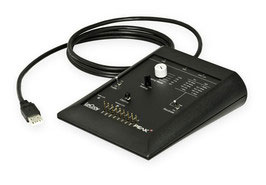PEAK-System Technik is a leading provider of hardware, software, and services for the industrial communication. The focus is on the field busses CAN and LIN. The product range includes: CAN/LIN interface modules for common PC hardware interfaces (PCI, cPCI, Mini PCI, PCIe, PC/104, USB, PC Card, and ExpressCard), Configurable microcontroller hardware with CAN interfaces for individual developments, measurement data acquisition, and control applications, Various software products for Windows® 7, Vista, and XP, used for diagnosis, monitoring, and influencing of CAN and LIN networks
PC CAN Hardware
PC CAN Interfaces
The PCAN-USB adapter enables simple connection to CAN networks. Its compact plastic casing makes it suitable for mobile applications.
The opto-decoupled version guarantees galvanic isolation of up to 500 Volts between the PC and the CAN side.
The package is also supplied with the CAN monitor PCAN-View for Windows® and the programming interface PCAN-Basic.
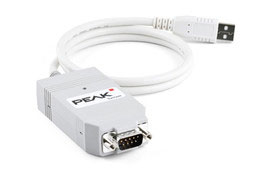
The CAN FD adapter PCAN-USB FD allows the connection of CAN FD and CAN networks to a computer via USB. A galvanic isolation of up to 500 Volts decouples the PC from the CAN bus. The simple handling and its compact plastic casing make the adapter suitable for mobile applications.
The new CAN FD standard (CAN with Flexible Data rate) is primarily characterized by higher bandwidth for data transfer. The maximum of 64 data bytes per CAN FD frame (instead of 8 so far) can be transmitted with bit rates up to 12 Mbit/s. CAN FD is downward-compatible to the CAN 2.0 A/B standard, thus CAN FD nodes can be used in existing CAN networks. However, in this case the CAN FD extensions are not applicable.
The monitor software PCAN-View and the programming interface PCAN-Basic for the development of applications with CAN connection are included in the scope of supply and support the new standard CAN FD.
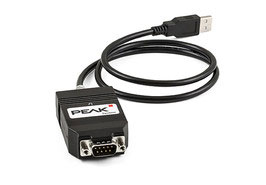
The PCAN-USB Pro FD adapter enables the connection of CAN FD and LIN networks to a computer via USB. Two field busses can be connected at the same time, up to four with appropriate adapter cables (2 x CAN FD, 2 x LIN). Each CAN FD channel is separately isolated against USB and LIN with a maximum of 500 Volts. Its robust aluminum casing makes the PCAN-USB Pro FD adapter suitable for mobile applications.
The new CAN FD standard (CAN with Flexible Data rate) is primarily characterized by higher bandwidth for data transfer. The maximum of 64 data bytes per CAN FD frame (instead of 8 so far) can be transmitted with bit rates up to 12 Mbit/s. CAN FD is downward-compatible to the CAN 2.0 A/B standard, thus CAN FD nodes can be used in existing CAN networks. However, in this case the CAN FD extensions are not applicable.
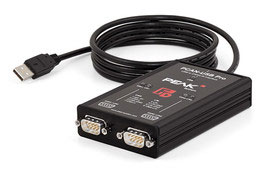
The PCAN-USB Pro adapter enables simple connection of a PC to CAN and LIN networks. Two field buses can be connected at the same time, with up to four connections available using appropriate adapter cables (2 x CAN, 2 x LIN). Its robust aluminum casing makes the PCAN-USB Pro adapter suitable for mobile applications.
The monitor applications PCAN-View and PLIN-View Pro as well as the PCAN-Basic and PLIN programming interfaces are also included in the scope of supply.
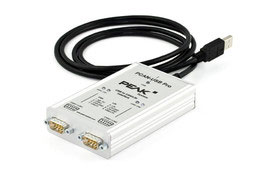
The PCAN-USB X6 is a CAN FD adapter for the USB port which allows the connection of up to 6 CAN FD or CAN busses. The device is therefore best suited for working with multiple CAN networks like the use in test benches with hardware-in-the-loop (HIL) simulations for motor vehicles or in the product line testing of CAN-based products.
The PCAN-USB X6 is installed in an aluminum profile casing and is shipped in versions with D-Sub connectors or M12 circular connectors. Especially the M12 version is suitable for use in harsh environments. In addition, a galvanic isolation of up to 300 Volts between the PC and the CAN side is guaranteed for the decoupled versions.
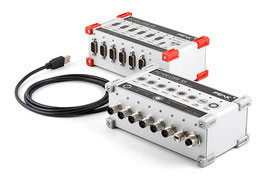
The PCAN-USB Hub provides multiple hardware interfaces through a USB connection. It offers the user one CAN, two RS-232, and two further USB interfaces. Its robust aluminum casing makes the PCAN-USB Hub suitable for mobile applications.
The package is also supplied with the CAN monitor PCAN-View for Windows® and the programming interface PCAN-Basic.
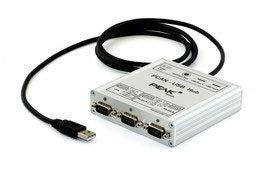
The PCAN-PCI card enables the connection of a PC with PCI slots to CAN networks.
The card is available as a single or dual-channel version. The opto-decoupled versions also guarantee galvanic isolation of up to 500 Volts between the PC and the CAN sides.
The package is also supplied with the CAN monitor PCAN-View for Windows® and the programming interface PCAN-Basic.
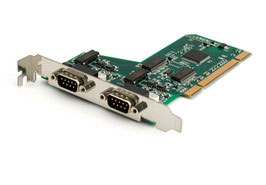
The PLIN-USB enables the connection of a Windows® computer to a LIN network via USB. The adapter supports the LIN protocol according to the standard ISO 17987 and complies with all LIN specifications up to version 2.2. The interface can be operated as a master or a slave.
The monitor software PLIN-View Pro and the PLIN programming interface for the development of applications with LIN connection are included in the scope of supply.
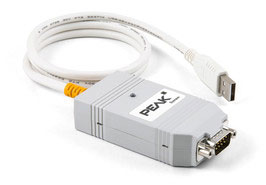
The PCAN-PCI Express card enables the connection of a PC with PCI Express slots to CAN networks. There is galvanic isolation of up to 500 Volts between the computer and CAN sides. There are versions with one, two and four channels.
The package is also supplied with the CAN monitor PCAN-View for Windows® and the programming interface PCAN-Basic.
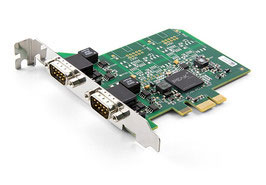
The plug-in card PCAN-PCI Express FD allows the connection of a PC with PCI Express slots to CAN FD and CAN networks. There is galvanic isolation of up to 500 Volts between the computer and CAN sides. The card is available as a single, dual, or four-channel version.
The new CAN FD standard (CAN with Flexible Data rate) is primarily characterized by higher bandwidth for data transfer. The maximum of 64 data bytes per CAN FD frame (instead of 8 so far) can be transmitted with bit rates up to 12 Mbit/s. CAN FD is downward-compatible to the CAN 2.0 A/B standard, thus CAN FD nodes can be used in existing CAN networks. However, in this case the CAN FD extensions are not applicable.
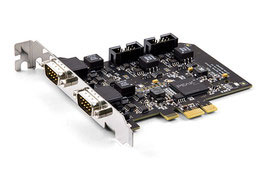
The PCAN-cPCI card enables the connection of an industrial computer system with CompactPCI to CAN networks. There is galvanic isolation of up to 500 Volts between the computer and CAN sides. The card is available as a dual or four-channel version.
The package is also supplied with the CAN monitor PCAN-View for Windows® and the programming interface PCAN-Basic.
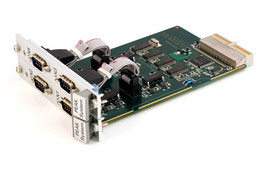
The PCAN-miniPCI card enables the connection of embedded PCs and laptops with Mini PCI slots to CAN networks.
The card is available as a single or dual-channel version. The opto-decoupled versions also guarantee galvanic isolation of up to 300 Volts between the PC and the CAN sides.
The package is also supplied with the CAN monitor PCAN-View for Windows and the programming interface PCAN-Basic.
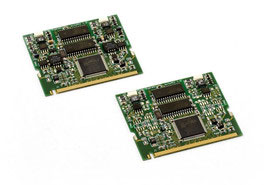
The PCAN-miniPCIe card enables the connection of embedded PCs and laptops with PCI Express Mini slots to CAN networks. There is galvanic isolation of up to 300 Volts between the computer and CAN sides. The card is available as a single or dual-channel version.
The package is also supplied with the CAN monitor PCAN-View for Windows® and the programming interface PCAN-Basic.
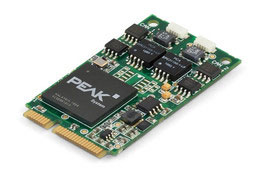
The PCAN-miniPCIe FD is a CAN interface for the PCI Express Mini slot. With its space-saving format, the plug-in card is a suitable solution for connecting embedded systems to up to four CAN FD and CAN networks. There is galvanic isolation of up to 300 Volts between the computer and CAN sides. The card is available as a single, dual, or four-channel version.
The new CAN FD standard (CAN with Flexible Data rate) is primarily characterized by higher bandwidth for data transfer. The maximum of 64 data bytes per CAN FD frame (instead of 8 so far) can be transmitted with bit rates up to 12 Mbit/s. CAN FD is downward-compatible to the CAN 2.0 A/B standard, thus CAN FD nodes can be used in existing CAN networks. However, in this case the CAN FD extensions are not applicable.
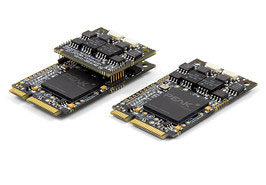
The PCAN-M.2 allows the connection of CAN and CAN FD networks via the M.2 interface (PCIe) of modern computer boards. With its small format, the plug-in card is ideal for embedded PCs, single-board computers (SBC), and compact embedded applications. There is a galvanic isolation between the computer and the CAN side up to 300 Volts. The card is available as single and dual-channel version.
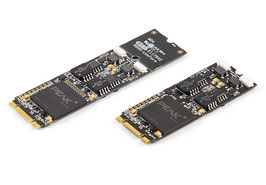
The PCAN-PC/104 card enables the connection of one or two CAN networks to a PC/104 system. Multiple PCAN-PC/104 cards can easily be operated using interrupt sharing.
The card is available as a single or dual-channel version. The opto-decoupled versions also guarantee galvanic isolation of up to 500 Volts between the PC and the CAN sides.
The package is also supplied with the CAN monitor PCAN-View for Windows® and the programming interface PCAN-Basic.
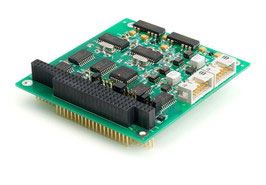
The PCAN-PC/104-Plus card enables the connection of one or two CAN networks to a PC/104-Plus system. Up to four cards can be operated, with each piggy-backing off the next. The CAN bus is connected using a 9-pin D-sub plug on the slot bracket supplied.
The card is available as a single or dual-channel version. The opto-decoupled versions also guarantee galvanic isolation of up to 500 Volts between the PC and the CAN sides.
The package is also supplied with the CAN monitor PCAN-View for Windows® and the programming interface PCAN-Basic.
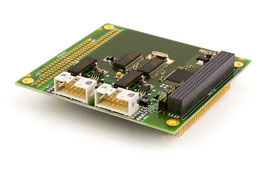
The PCAN-PC/104-Plus Quad card enables the connection of four CAN networks to a PC/104-Plus system. Up to four cards can be operated, with each piggy-backing off the next. The CAN bus is connected using a 9-pin D-Sub plug on the slot brackets supplied. There is galvanic isolation of up to 500 Volts between the computer and CAN sides.
The package is also supplied with the CAN monitor PCAN-View for Windows® and the programming interface PCAN-Basic.
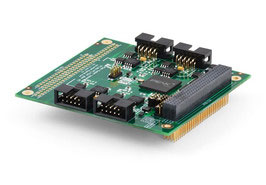
The PCAN-PCI/104-Express card enables the connection of one, two, or four CAN busses to a PCI/104-Express system. Up to four cards can be stacked together. The CAN bus is connected using a 9-pin D-Sub plug on the slot brackets supplied. There is galvanic isolation of up to 500 Volts between the computer and CAN sides. The card is available as a single, dual, or four-channel version.
The package is also supplied with the CAN monitor PCAN-View for Windows® and the programming interface PCAN-Basic.
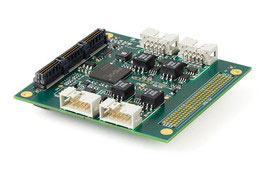
The PCAN-PCI/104-Express FD allows the connection of PCI/104-Express systems to CAN and CAN FD busses. The PCI/104-Express specification establishes PCI Express for the PC/104 form factor wherewith up to four cards can be stacked. Based on this, standardized modular embedded systems such as industrial PCs can be realized. The CAN bus is connected via 9-pin D-Sub connectors to the supplied slot brackets. There is a galvanic isolation between the computer and the CAN side up to 500 Volts. The card is available as a single, dual, or four-channel version.
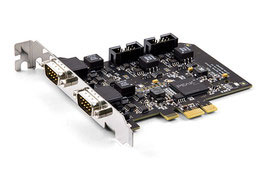
The CAN adapter PCAN-ExpressCard 34 allows the connection of a CAN bus to embedded PCs and laptops with ExpressCard slots. A galvanic isolation of up to 300 Volts decouples the PC from the CAN bus.
The package is also supplied with the CAN monitor PCAN-View for Windows® and the programming interface PCAN-Basic.
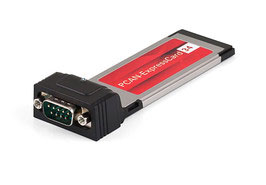
The PCAN-ExpressCard provides a connection between a CAN bus and a laptop or desktop PC with an ExpressCard slot.
The card is available in single and dual-channel versions. There are also galvanically separated versions which guarantee galvanic separation up to a maximum of 300 Volts between the PC and CAN sides.
The package is also supplied with the CAN monitor PCAN-View for Windows® and the programming interface PCAN-Basic.
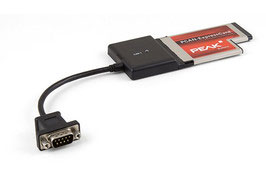
The card allows the connection of a CAN bus to a laptop or to a desktop PC with a PC Card slot.
The card is available as a single or dual-channel version. There are also galvanically separated versions which guarantee galvanic separation up to a maximum of 100 Volts between the PC and CAN sides.
The package is also supplied with the CAN monitor PCAN-View for Windows® and the programming interface PCAN-Basic.
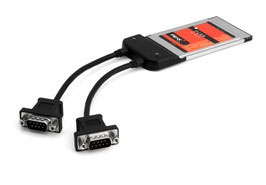
The PCAN-ISA card enables simple, cost-effective connection of computer systems with ISA slots to CAN networks. Multiple PCAN-ISA cards can easily be operated using interrupt sharing.
The card is available as a single or dual-channel version. The opto-decoupled versions also guarantee galvanic isolation of up to 500 Volts between the PC and the CAN sides.
The package is also supplied with the CAN monitor PCAN-View for Windows® and the programming interface PCAN-Basic.
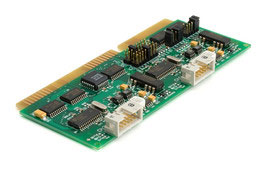
This parallel connection to CAN converter is a sensible alternative to using a PCAN-USB adapter for connecting to a CAN network, especially for older PCs and laptops. Depending on the parallel interface present, it can be operated in “Multiplex” or “Enhanced Parallel Port” mode. Power is supplied to the PCAN-Dongle through a special adapter connected to the PC's keyboard output.
The opto-decoupled version also guarantees galvanic isolation of up to 500 Volts between the PC and the CAN sides.
The package is also supplied with the CAN monitor PCAN-View for Windows® and the programming interface PCAN-Basic.
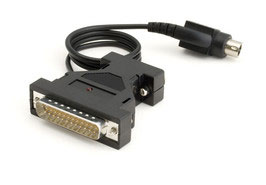
Chip Solutions
For the CAN and CAN FD connection of your hardware design we provide several solutions.
Based on an FPGA, up to 4 CAN channels can be implemented via the PCI Express bus using the chip solution PCAN-Chip PCIe FD. With the license from PEAK-System, the FPGA can be programmed via an image with the corresponding functionality.
In addition to the related documentation, the scope of supply includes licenses for the Windows and Linux device drivers, the CAN monitor PCAN-View, and the PCAN-Basic API.
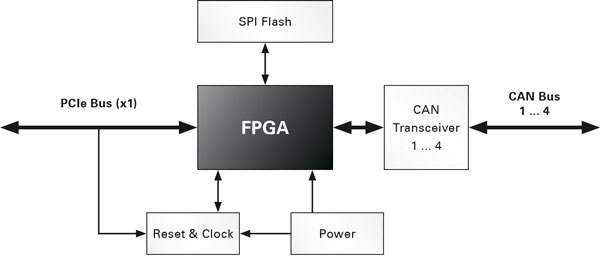
For custom hardware designs a CAN connection can be implemented with the Stamp module, which communicates via USB 2.0 with the hardware. The integrated CAN controller supports the protocols CAN 2.0 A/B as well as CAN FD. The physical CAN connection is determined by external wiring. The Stamp module with its single-sided mounting and plated half-holes is suitable for automatic assembly.
The optional PCAN-Chip USB Eval board simplifies the development of a custom board based on the Stamp module.
In addition to the documentation for the integration of the Stamp module, the scope of supply of the PCAN-Chip USB includes licenses for the Windows and Linux device drivers, for the CAN monitor PCAN-View, and for the PCAN-Basic API.
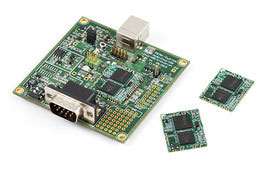
Couplers & Converters
The PCAN-Optoadapter is a universal plug-on adapter to allow galvanic isolation of High-speed CAN bus systems.
Its integrated logic means that decoupling can be installed at any point in the CAN network.
The PCAN-Optoadapter can be used in CAN FD busses with data bit rates up to 2 Mbit/s and nominal bit rates up to 1 Mbit/s.
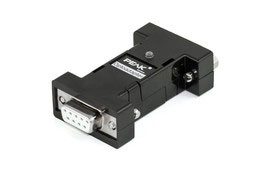
The PCAN-Repeater DR establishes a connection between two High-speed CAN busses with galvanic isolation of up to 5 kV. Both CAN channels are decoupled from each other and from the power supply. All message traffic including error frames is forwarded 1:1 between both channels, if necessary, in one direction only. The PCAN-Repeater DR behaves passively and is transparent from the perspective of the CAN bus. LEDs display the current bus status. With its DIN rail casing and extended temperature range support, this module is suitable for use in an industrial environment.
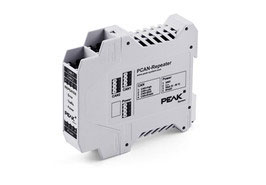
For use in explosion-proof areas or for EMC measurements, the PCAN-LWL can be used to replace a stretch of CAN network with a fiber-optic line at any point. There are the options of conversion to High-speed CAN or Low-speed CAN. The modules are supplied with power externally.
The PCAN-LWL can be used in CAN FD busses with data bit rates up to 5 Mbit/s and nominal bit rates up to 500 kbit/s.
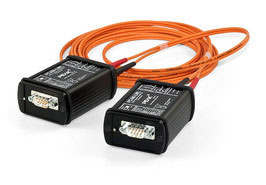
For use in explosion-proof areas or for EMC measurements, the PLIN-LWL can be used to replace a stretch of LIN network with a fiber-optic line at any point. The modules are supplied with power externally.
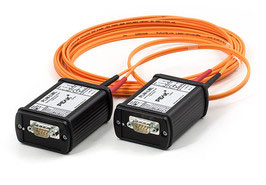
The PCAN-AU5790 bus converter establishes a connection between a High-speed CAN bus (ISO 11898-2) and a Single-wire CAN bus (SAE J2411). One of the most important potential applications of the bus converter is a simple connection between a PEAK CAN interface (e.g. PCAN-USB) and a Single-wire CAN bus.
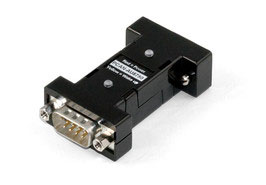
The PCAN-B10011S bus converter establishes a connection between a High-speed CAN bus (ISO 11898-2) and a Truck Trailer CAN bus (ISO 11992-1). One of the most important potential applications of the bus converter is a simple connection between a PEAK CAN interface (e.g. PCAN-USB) and a Truck Trailer CAN bus.
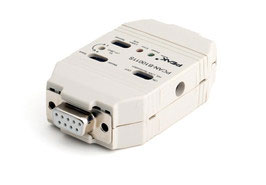
The PCAN-TJA1054 bus converter establishes a connection between a High-speed CAN bus (ISO 11898-2) and a Low-speed CAN bus (ISO 11898-3). One of the most important potential applications of the bus converter is a simple connection between a PEAK CAN interface (e.g. PCAN-USB) and a Low-speed CAN bus.
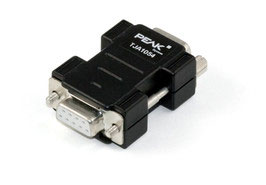
I/O Modules
The plug-in module PCAN-MicroMod represents a straightforward possibility to provide electronic circuits with I/O functionality and a CAN connection. Configuring is done with a Windows® program which sends the configuration data to the module via CAN. Several modules can be configured independently on a CAN bus.
With various PCAN-MicroMod motherboards, it can be used in device and plant engineering and in the motor vehicle industry. An optional evaluation board simplifies the enhancement and development of custom boards.
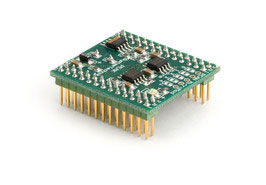
The plug-in module PCAN-MicroMod represents a straightforward possibility to provide electronic circuits with I/O functionality and a CAN connection. Configuring is done with a Windows® program which sends the configuration data to the module via CAN. Several modules can be configured independently on a CAN bus.
With various PCAN-MicroMod motherboards, it can be used in device and plant engineering and in the motor vehicle industry. An optional evaluation board simplifies the enhancement and development of custom boards.
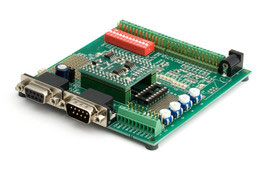
The motherboards for the PCAN-MicroMod provide an application-oriented environment. Typical characteristics of this product group include a wide supply voltage range and the protective circuits for the inputs and outputs. CANopen® firmware is available for all PCAN-MicroMod motherboards.
The Analog 1 & 2 motherboards serve general analog requirements.
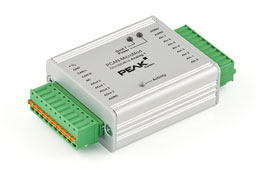
The motherboards for the PCAN-MicroMod provide an application-oriented environment. Typical characteristics of this product group include a wide supply voltage range and the protective circuit for the inputs and outputs. CANopen® firmware is available for all PCAN-MicroMod motherboards.
The Digital 1 & 2 motherboards serve general digital requirements.

The motherboards for the PCAN-MicroMod provide an application-oriented environment. Typical characteristics of this product group include a wide supply voltage range and the protective circuit for the inputs and outputs. CANopen® firmware is available for all PCAN-MicroMod motherboards.
The Mix 1 and Mix 2 motherboards combine general analog and digital requirements with temperature recording functions.

The motherboards for the PCAN-MicroMod provide an application-oriented environment. Typical characteristics of this product group include a wide supply voltage range and the protective circuit for the inputs and outputs. CANopen® firmware is available for all PCAN-MicroMod motherboards.
The Mix 3 motherboard allows the use of all inputs and outputs available on the PCAN-MicroMod, which opens up a wide range of potential applications in the automotive and industrial sectors.
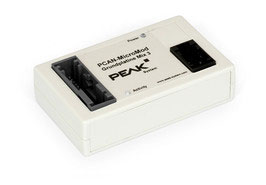
The Multiple Input Output module (MIO) is a universal, modular controller for use both in the industrial and automotive fields.
The module has two CAN interfaces as well as multiple analog and digital inputs and outputs. Incoming signals can be processed by the microcontroller and then forwarded to the CAN interfaces or output channels. For this purpose, the behavior of the PCAN-MIO module can be freely configured using a comprehensive Windows® software. A large number of function blocks and other settings are available to help the user in creating such a configuration.
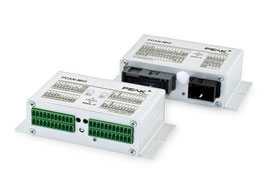
The Thermocouple measuring unit offers connections for 8 thermoelements for different temperature ranges (J, K, T).
Measurement data can be preprocessed and transmitted via CAN bus using a central microcontroller. Configuration work involves using Windows® software on a computer connected to the same CAN bus.
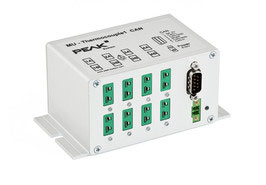
The PLIN-Slave is an evaluation board with an interface for a LIN 2.0 bus. The device also has comprehensive I/O functionality which is accessible through control and display elements.
The device is used in development and education, for example, for testing purposes or as a teaching aid for handling the LIN protocol.
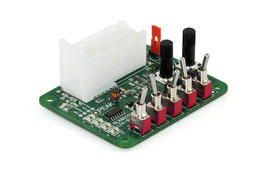
The PCAN-GPS is a programmable sensor module for position and orientation determination. It has a satellite receiver, a magnetic field sensor, an accelerometer, and a gyroscope. The sampled data can be transmitted on a CAN bus and logged on the internal memory card. The data processing is performed by a microcontroller of the NXP LPC4000 series.
Using the supplied library and the Yagarto GNU ARM toolchain (contains the GNU Compiler Collection GCC for C and C++), custom firmware can be created and then transferred to the module via CAN. This gives a whole range of options for manipulation, evaluation, filtering, and routing of the data traffic.
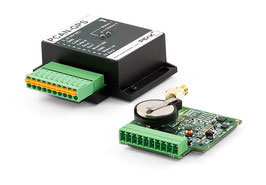
Grid Connect® has developed the ARM7 microcontroller gridARM™ as System on a Chip solution (SoC) aiming for embedded applications in the field of industrial communication. The PEAK-gridARM evaluation board is a Linux-based development platform for the gridARM™ microcontroller. It has connectors for Gigabit Ethernet, High-speed CAN, USB 2.0, RS-232, SPI, and I²C. Digital and analog inputs of the evaluation board are manipulated by push buttons and potentiometers. The microcontroller state as well as the states for supply and data traffic are indicated by LEDs. A board support package (BSP) for Linux gives access to the hardware resources of the PEAK-gridARM evaluation board.
The gridARM™ microcontroller by the U.S. company Grid Connect is distributed in Europe exclusively by PEAK-System.
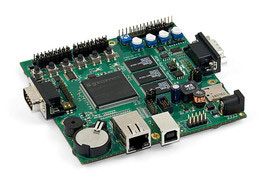
Routers & Gateways
Programmable 6-Channel Router for CAN and CAN FD with I/O and Data Logger
With six channels, the PCAN-Router Pro FD links the data traffic of modern CAN FD and classic CAN buses. the router is equipped with an analog input and four digital I/Os. The CAN messages can be recorded on the internal memory or on an inserted memory card and later read out via the USB connection.
The PCAN router FD comes with 2 digital I/Os, 1 analog input (0 - 33 V), Internal memory: 16 GByte eMMC and SD card slot for additional memory. supports recording of CAN data and error frames and USB connection for accessing the data memory (e.g. recorded log data)
Optional on request: Ethernet interface via RJ-45 socket or BroadR-Reach® interface via D-Sub connector
The transfer of the firmware via CAN requires a PEAK CAN interface.
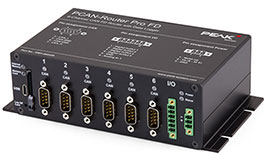
The PCAN-Wireless Gateway allows the connection of different CAN busses over IP networks. CAN frames are wrapped in TCP or UDP message packets and then forwarded via the IP network from one device to another. The PCAN-Wireless Gateway provides one WLAN connection and two High-speed CAN interfaces. The module is supplied in a plastic case with two D-Sub connectors or a Tyco automotive connector.
The configuration of the device is done via a comfortable web interface. Besides providing a variety of status information, the website can directly manage settings for the device itself, communication interfaces, and message routing.
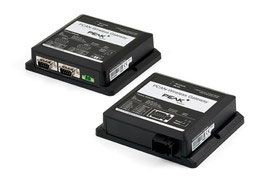
The PCAN-Wireless Gateway DR allows the connection of different CAN busses over IP networks. CAN frames are wrapped in TCP or UDP message packets and then forwarded via the IP network from one device to another. The PCAN-Wireless Gateway DR provides one WLAN connection and two High-speed CAN interfaces. With its DIN rail casing and the support of the extended temperature range, the module is suitable for use in an industrial environment.
The configuration of the device is done via a comfortable web interface. Besides providing a variety of status information, the website can directly manage settings for the device itself, communication interfaces, and message routing.
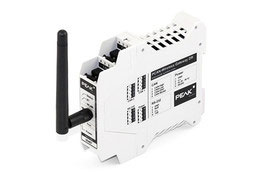
The PCAN-Ethernet Gateway DR allows the connection of different CAN busses over IP networks. CAN frames are wrapped in TCP or UDP message packets and then forwarded via the IP network from one device to another. The PCAN-Ethernet Gateway DR provides one LAN connection and two High-speed CAN interfaces. With its DIN rail casing and the support of the extended temperature range, the module is suitable for use in an industrial environment.
The configuration of the device is done via a comfortable web interface. Besides providing a variety of status information, the website can directly manage settings for the device itself, communication interfaces, and message routing.
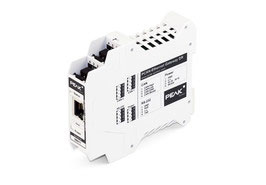
Virtual PCAN-Gateway Gateway DR
The Virtual PCAN-Gateway software package provides access for Windows computers to devices of the PCAN-Gateway product line over IP-based networks. Various LAN and WLAN network adapters can be used.
Analog to the bidirectional connection of two PCAN-Gateways, message forwarding with so-called routes must be set up between the hardware and the software. At first, two routes have to be created on the configuration website of the hardware, one for sending and another for receiving. Then, the appropriate counterparts of these routes must be established within the configuration software.
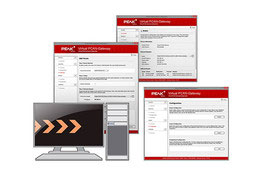
The PCAN-LIN module enables CAN, LIN, and serial participants to communicate. The module is supplied in a plastic casing and includes firmware which enables data to be exchanged between the different bus systems. Various modes can be set up with the aid of configuration software. Then for instance the module acting as the LIN master can request data and route the incoming LIN data to the CAN bus and/or the serial interface. Data can be routed between CAN and LIN with an ID offset.
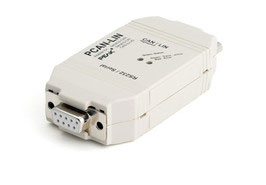
PCAN-RS-232 is a programmable module for the communication between RS-232 and CAN. The conversion of data traffic is done via a NXP LPC21 series microcontroller.
Using the supplied library and the Yagarto GNU ARM toolchain (contains the GNU Compiler Collection GCC for C and C++), custom firmware can be created and then transferred to the module via CAN. This gives a whole range of options for manipulation, evaluation, filtering, and routing of the data traffic.
On delivery the PCAN-RS-232 is provided with a demo firmware that routes from CAN to RS-232 and vice versa. It allows to configure the data transfer as well as the hardware with serial control commands. The corresponding source code is included as an example in the scope of supply.
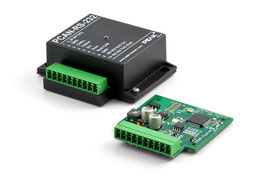
The PCAN-Router is a dual-channel CAN module whose NXP LPC21 series programmable microcontroller provides the option of using the CAN messages on both channels on a flexible basis. This gives a whole range of options for manipulation, evaluation, filtering, and routing of CAN messages.
Using the supplied library and the Yagarto GNU ARM toolchain (contains the GNU Compiler Collection GCC for C and C++), custom firmware can be created and then transferred to the module via CAN. At delivery, the PCAN-Router is equipped with a demo firmware that forwards CAN messages 1:1 between both channels at 500 kbit/s. The corresponding source code is included as example in the scope of supply.
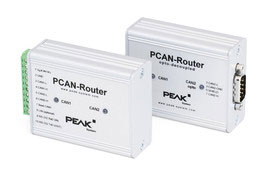
The PCAN-Router FD allows the connection to two CAN FD or CAN busses. Based on a ARM Cortex M4F microcontroller, the module‘s behavior and the data routing between both CAN FD channels is freely programmable. In particular, the module allows the conversion from CAN to CAN FD or vice versa. This makes it easy to accomplish the integration of CAN FD applications into existing CAN 2.0 networks.
Using the programming library and the GNU compiler for C and C++, a firmware is created and then transferred to the module via CAN. On delivery, the PCAN-Router FD is provided with a demo firmware. The corresponding source code is included as example in the scope of supply.
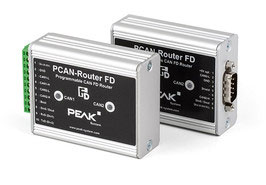
The PCAN-Router DR has two High-speed CAN channels. Their bit rate is adjusted with a rotary switch on the device front. The module forwards the message traffic bi-directionally 1:1 between both connected CAN busses.
The ports of the device are isolated against each other and against the power supply with at least 500 V. Furthermore, CAN 1 has a separation voltage of up to 5 kV conforming with IEC 60601-1. With its DIN rail casing and the support of the extended temperature range, the module is suitable for use in an industrial environment.
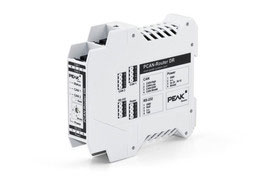
The PCAN-Router Pro allows to join the data traffic from four High-speed CAN busses. The behavior of the router is configured via the CAN bus with the provided Windows program PPCAN-Editor. As well as pure forwarding, the CAN data can be processed, manipulated, and for example, filtered in a number of different ways. There are a variety of function blocks and other settings available to the user for configuration setup. Furthermore, there is a virtual fifth CAN channel which is used for recording all data traffic to a CompactFlash card.
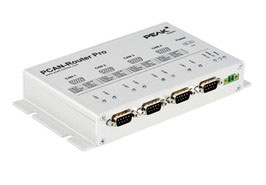
PCAN-GPRS Link is a module for recording and forwarding vehicle data. There are two freely programmable microcontrollers within the unit which process internal vehicle data.
The PCAN-GPRS Link is provided as a development platform for telematic applications. An API allows simple integration within a specific application environment. The PCAN-GPRS Link supports the evaluation of FMS and Bus FMS data (Fleet Management System). This produces consumption related vehicle data. The DTCO info interface also allows the connection and processing of a digital tacho with access to information such as driver identification and driver working time. The GPS module can be used to determine location and output the direction of travel.
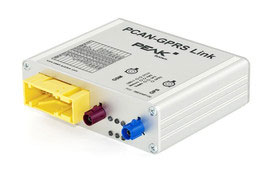
Diagnostics & Education
Compact Diagnostic Device for CAN and CAN FD Buses
The PCAN-MiniDiag FD is a compact, low-cost handheld device for basic diagnosis and checking of CAN and CAN FD buses.Service technicians and developers can easily access networks of vehicles, machines, or industrial equipment whose configuration is unknown. the device has measuring functions for the termination, bus load, and voltage levels at the CAN connector.
Complies with CAN specifications 2.0 A/B and FD and supports CAN FD support for ISO and Non-ISO standards.
The PCAN MininDiag FD comes with D-Sub, 9-pin (in accordance with CiA® 303-1), OLED display with 128 x 128 pixel resolution, power supply via exchangeable batteries (3 x Micro AAA with 1.2 V or 1.5 V), operation via membrane keypad with four keys and plastic casing with increased Ingress Protection IP42.
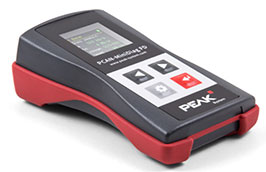
PCAN-Diag 2 is a handheld diagnostics unit with a wide range of functions to allow investigation of a CAN bus, such as detection of the CAN bit rate, bus load measurement, and termination measurement. As well as receiving CAN messages, it can transmit either individual messages or entire sequences of them. In addition, the internal memory card allows tracing and playback of the CAN traffic.
The integrated two-channel oscilloscope enables visualization of CAN signals. Single CAN IDs and various events can be used as triggers. The CAN frames are decoded from the analog signal, for example, to detect errors in the frame.
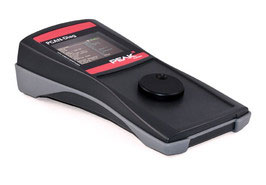
The PCAN-Diag FD is a handheld device for diagnosis of the communication on a CAN bus. Possibilities for diagnosis are available on the protocol layer by handling CAN 2.0 and CAN FD messages as well as on the physical layer by using the oscilloscope function and further measuring functions for voltage and resistance.
The oscilloscope function is used for a qualitative assessment of the signal course on the CAN bus. Two independent measuring channels sample both lines CAN-High and CAN- Low with up to 100 MHz. Based on the signal course, the PCAN-Diag FD decodes CAN frames and shows their elements in the scope graphics.
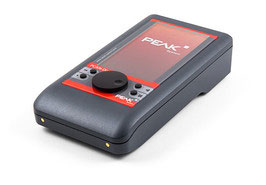
The PCAN-MiniDisplay is used as a human-machine interface for the visualization of CAN data. For the connection to the CAN bus, it has two High-speed CAN connectors. The graphic representation of incoming CAN data is configured before using the unit and then is performed on a TFT display.
The PCAN-MiniDisplay can alternatively be used for data logging. The data traffic is recorded to a memory card and can be replayed or analyzed on a PC later on.
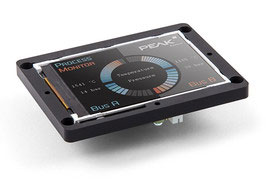
The Serial Bus Simulator (SBS) generates data traffic on the CAN, LIN, V24, I2C and SPI bus systems to validate hardware and display the relevant protocol structures.
SBS could be used, for example, in measurement technology for protocol analysis or for educational purposes for demonstrating digital message transfer.
